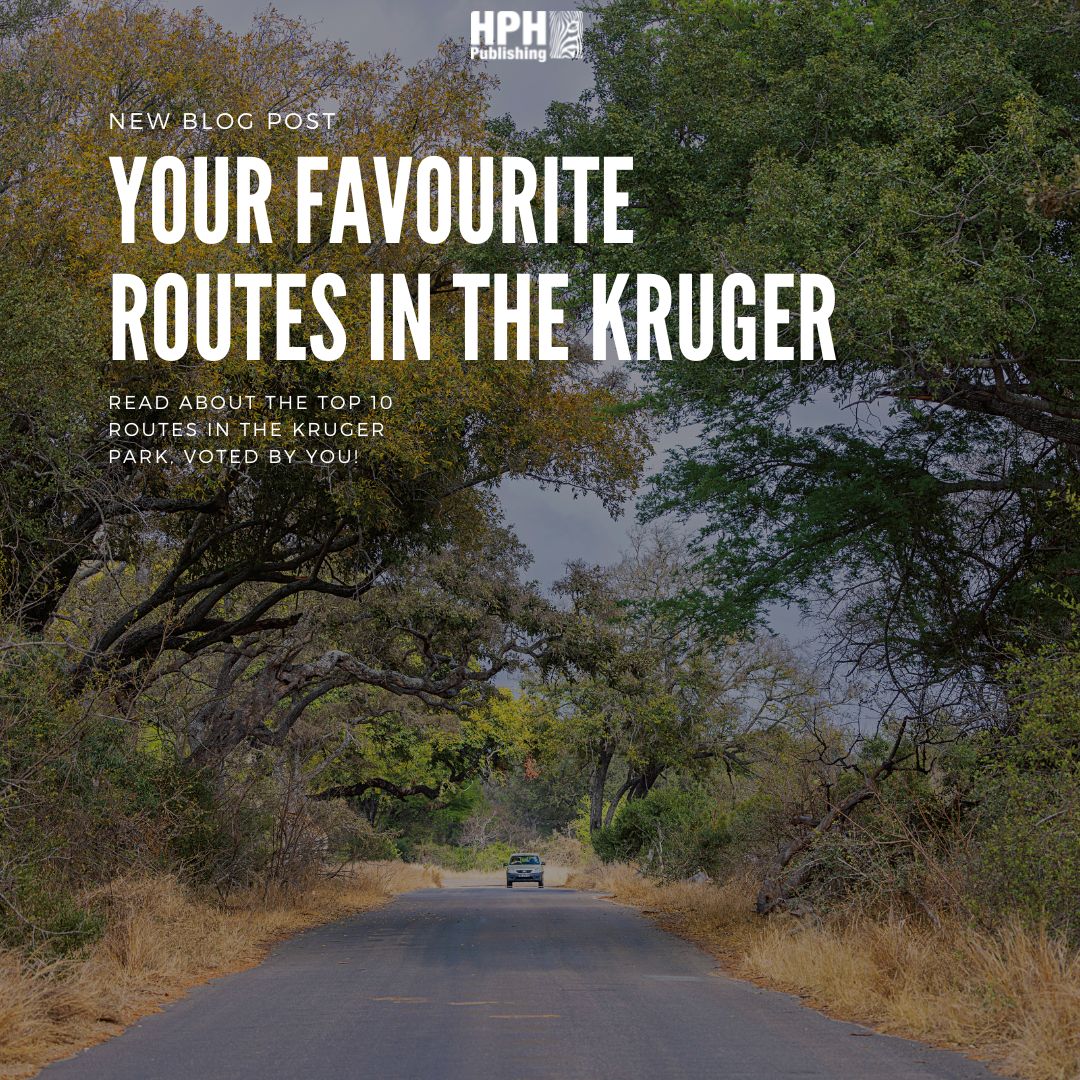
Your TOP 10 Favourite Roads in the Kruger
Share
We asked you to tell us about your favourite routes in the Kruger National Park. Now you can read which routes received the most votes and made it into the Top 10!
- H4-1

This is one of the most popular roads in southern Kruger. The main attraction is that the road hugs the perennial Sabie River, is extremely scenic and offers ideal habitat for most kinds of predator.
The probability of good sightings and witnessing action is high on this road. The downside is that everyone knows this, and traffic congestion does occur around good sightings. Courtesy and lots of patience is the name of the game.

Along the river it is the riverine vegetation that enchants. Many trees on this road are named and numbered. Wonderful specimens of sycamore fig, jackalberry, knob thorn and river thorn occur. On the opposite side of the river typical Sabie thorn thicket is the dominant vegetation. Different kinds of thorn-bearing trees (formerly known as acacias) make up the dominant vegetation. One of these is the horned thorn that is typical and particularly common along this road. Before coming into leaf, the trees are easily recognised by their huge white thorns that resemble the wide horns of African cattle. This tree is number 168.1. in the South African National List of Indigenous Trees.

The Nkuhlu Picnic Site is a welcome stopping place halfway between Skukuza and Lower Sabie. Stretch your legs, have your picnic, mind the baboons (they are very clever at snatching food) and take your binoculars to do some birding. There is a small shop, fast-food outlet, gas barbeques for hire, hot water and restrooms.
- S114

Game drives are generally rewarding along the S114, especially the southern and northern sections. Although this road is often corrugated in places, it is worth taking. There are several escape routes to the tarred H3. Low traffic volumes and intimate encounters are well worth the dust.

The road traverses several ecozones. From the south, the first section is still part of the Malelane mountain bush veld land scape – mostly bushwillow shrubs and mixed grasses with a few patches of sweet grass and magic guarri. The grass attracts grazers and the bushwillow browsers and when the guarri is in fruit, bird parties abound. Stunted impala lily shrubs grow in profusion on the stony flats close to the intersection. Impala lilies flower during the winter months. Spot the large leafed rock fig on the low granite hillock.

- S25

This route runs to the north of the perennial Crocodile River, which forms the southern boundary of the park. It passes through four different landscape types or ecozones and thus offers great variety in vegetation and animal life.

From east to west it briefly meanders through knob-thorn and marula savanna rich in grazing species, then through a thicket section with clay soils dominated by Delagoa thorn where the short grass is sweet and seasonal pans are surrounded by magic guarri. The next landscape is rather dull and flat with dense thorn thickets of low sickle-bush. Before the S119 turn-off, the sickle-bush gives way to mixed bushwillow woodlands until it merges with the S114 on its western extremity. Game viewing is usually good all along this road. Animals from the interior cross it to drink from the Crocodile River, especially during the dry season.

- S121

The road roughly follows the course of the Timfenheni seasonal stream. This is a narrow intimate road passing through dense bushwillow woodland with a sickle-bush understorey towards the south. Where the road runs closer to the stream, clay depressions are indicated by stands of magic guarri. Along the stream bank typical riverine vegetation is found with mature specimens of knob-thorn, jackalberry, apple-leaf and tamboti. It offers a home for vervet monkey populations.

Visibility is mostly restricted to a few metres from the road but being browsers, kudu find this vegetation attractive.

- S100

Many visitors rate this road as the best for game viewing in the Kruger. That may be so but even the most popular road may be devoid of visible game at times. However all the best conditions for game viewing are present and the chances of seeing game are better than elsewhere.

The road meanders close to the N’wanetsi River, which may not be flowing but still has permanent waterholes where game can drink. N’wanetsi means ‘shimmering water’ in Shangaan and probably refers to the lovely pools along this river. These attract game from the surrounding plains since most animals need to drink regularly.

- S56

The S56 follows the course of the seasonal Mphongolo River and is rated as one of the best drives in the north.

Yet, as with any other drive, you may be extremely lucky and see a lot of game or perhaps nothing at all. But there are always plenty of bird species and some of the best wildlife encounters have been reported along this route. Impressive trees fringe the Mphongolo. The most outstanding of these are the huge nyala trees and the massive jackal berries. Both these have huge trunks and cannot be missed. The nyala tree is found along the Sabie River, but is only common in the northern parts of the park (especially along the Mphongolo River) where it grows on alluvial soils along riverbanks. The Babalala Picnic Site marks the end of this pleasant route.

- H10

The H10 is one of the finest game-viewing roads in the park. Visibility is good and game densities are high. The possibility of sighting all of the Big Five in one game drive is high.

The southern end of this road crosses the Sabie River, which is famous for its magnificent sunset views and game sightings in the riverbed. This must surely be one of the most popular bridges in the park. Look out for reedbuck between the crossings of S29 and S128. Here, the road runs along the Mlondozi drainage line and a vlei area provides the ideal habitat for them. Reed buck are only active in the early morning and late afternoon. During the rest of the day they lie down in grass tall enough to conceal them.

- S110

The tarred part of the road from the H3 closest to the Malelane Gate leads to the Berg-en-Dal Rest Camp. It then continues as a dirt road and makes a loop to join the H3 further north.

The S110 traverses the heart of Malelane mountain bushveld. This is typical of the vegetation in the southwestern parts of the park where the terrain is mountainous, the soils coarse and the grass mostly unpalatable for much of the year. It is an attractive landscape as the road winds through several granite hills. To the south the Khandzalive Hill (839 m) is the highest peak in the park and is visible soon after the road passes the Tlhalabye Hill (630 m) on the northern side of the road. The road gradually descends into the Matjulu valley with the Matjulu Hill (627 m) rising in the distance.
- H7

The Orpen–Satara road takes you through excellent game country and is one of the better roads for encountering predators such as lion, leopard and cheetah.

From the east, the first section of the road passes through beautiful and open park-like marula/knob-thorn savanna with underlying basalt. This is ideal habitat for cheetah. These fast and lithe predators hunt by first stalking their prey to within a short distance, then accelerating rapidly before tripping and killing it. Their preferred prey is impala but they will also take immature kudu, waterbuck and steenbok. Despite their speed, they are timid and will easily be chased off their kill by hyena, lion or jackal. After the hunt they have a short rest, then they gulp down their food before a scavenger arrives.
- S99

The Mahonie loop circles the hill on which the Punda Maria Camp is built and is renowned for plants and animals that are scarce elsewhere in the park. The road was named after the many specimens of pod mahogany in the Punda Maria area. But this is not the only majestic tree species along this road. The hill slopes support an astounding diversity and several are unique to the park.

In summer this is an extremely pleasant drive through a wonderland of different flowering shrubs and wild flowers. The Pride-of-De-Kaap scrambling shrubs offer cascading, orchidlike, peach coloured flowers amongst their butterflyshaped leaves. This is a close family member of the abundant mopane. The striking blue flowers of the plumbago shrubs attract butterflies and birds. Then there are the flame lilies, flame climbing bushwillows, wild heliotropes, violets, wild morning glories, vernonias, wild hibiscus and many more. The botanical diversity is simply amazing.
The text for this article was taken from Kruger Self-Drive – Second Edition. To find out more about the book, and to order, click here.


2 comments
GREAT CHOICE AND ANALYSIS FOR SPMEBODY VISITING KRUGER FOR THE FIRST TIME
the s114 and the S119 is always full of surprises